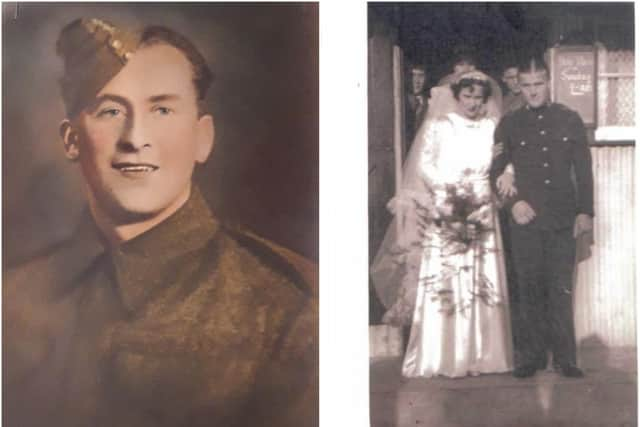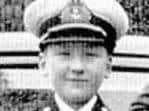More stories behind the names of the WW2 soldiers on Warwick's war memorial
and live on Freeview channel 276
Unlocking Warwick is researching the stories behind the names of those who died in the Second World War on the Church Street memorial in the town.
They are asking people to get in touch with information about those who died, and also if they have memories of life in Warwick during the war.
Advertisement
Hide AdAdvertisement
Hide AdHere are more of the stories behind the names on Warwick’s war memorial in Church Street uncovered by the volunteers of Unlocking Warwick.


The Worst Affected Warwick Family
Alfred and Margaret Howlett kept the Warwick Tavern, now The Old Fourpenny Shop, 27-29 Compton Street.
They had four sons serving in WW2; three of them did not survive. Alf ‘Slim’ Howlett was wounded on May 1940 during the British Expeditionary Force retreat towards Dunkirk, and died of his injuries in Warwick Hospital.
He is buried in Warwick Cemetery. William Henry Howlett, known as Harry, was killed in action at Tobruk in 1942, and George William Howlett, known as Bill, died in a road accident in February 1945 while he was serving in East Africa.


Advertisement
Hide AdAdvertisement
Hide AdThe Warwick Advertiser reported that: “The sympathy of the whole town has been deeply stirred by the tragic fate that has befallen the Howlett family”.
A Deadly Parachute Drop
Roland Hodgkisson worked in his father’s barber shop at 27 Emscote Road.
It is still a hairdresser’s salon today. Roland joined the First Battalion of the Parachute Regiment and served as the company barber during his training.
His niece, Jane Nockalls, writes: “He was 26 years old when he was killed in North Africa. It was his first parachute jump and the Germans were waiting for them and shot them down as they jumped.”
The Youngest of the Warwick Fallen
Advertisement
Hide AdAdvertisement
Hide AdCyril Latch served as a midshipman on HMS Jervis Bay, a liner requisitioned by the Royal Navy and converted into an armed merchant cruiser, with some extremely old guns brought back into service.
On November 5 1940, it was the sole escort for a large convoy of 37 merchant ships crossing the Atlantic when they encountered the German battlecruiser Admiral Scheer south of Iceland.
The captain of the Jervis Bay, Edward Fegen, immediately ordered the crew to attack the German warship, even though they were hopelessly outgunned, allowing the convoy to scatter.
Although the German shells ravaged the British ship, and the captain was wounded and many crew killed, Fegen and the surviving crew fought on until their ship was sunk.
Advertisement
Hide AdAdvertisement
Hide AdCaptain Fegen, and many of the crew, went down with the ship. Most of the merchant ships in the convoy escaped. Captain Fegen was awarded a posthumous Victoria Cross. Cyril Latch’s role in this dramatic incident is not know. He was only 17.
His death clearly had a distressing effect on his father, also Cyril, who was a noted manufacturer of wire rope (Latch and Bachelor). He had survived the First World War when he was wounded at the Somme then returned to the front with the Royal Flying Corps.
Some months after the death of his son, young Cyril, he was arrested in Leamington when the car he was driving hit two others and the police discovered he was’entirely unfit to drive’.
The Warwick Advertiser reported the court case in some detail under the headline, ‘Took Too Much Medicinal’.
Advertisement
Hide AdAdvertisement
Hide AdThe court heard that Captain Latch was suffering from severe anxiety and had been prescribed sleeping tablets. He had taken more than the recommended dose.
The bench found that he was under the influence of drugs, but the magistrates took account of the fact that he was grieving for his son, killed in the Jervis Bay incident, and the case was dismissed.
A Civilian for just four days
James O’Connell had been a career soldier for 17 years when in 1939 he took his discharge to start a new life as a civilian.
His parents lived at 5 Wathen Road in Warwick and James got a job with Lockheed Brakes in Leamington. His civilian career lasted just four days.
Advertisement
Hide AdAdvertisement
Hide AdHe was recalled to service as war broke out, and became a Sergeant in the Royal Tank Regiment. He survived the retreat from Dunkirk in 1940, and in 1942 married Eileen Potter.
But two years later, in November 1944 he died of his wounds in Italy as the Allies were pressing for victory in Europe.
Two Deaths in Warwick
Warwick didn’t escape entirely unscathed during WW2, as local resident Patrick Rafferty recalled. “My grandfather Harry Marston, serving in the Royal Warwickshire Regiment, had survived the Battle of the Somme in the 1914-18 conflict.
But he became a rare casualty of enemy action in Warwick during the Second World War. Harry, by then a reservist, was walking home on St Mary’s Common in May 1941 when a German aircraft dropped a stick of bombs.
Advertisement
Hide AdAdvertisement
Hide AdHe was killed instantly along with his friend, James Hiatt”.
The bombs had fallen on ‘Lammas Field’ at the bottom of Linen Street, throwing up a huge mound of earth. It’s thought the German plane might have been targeting the nearby gas works. Marston was 49 and lived at 21 Linen Street.
Hiatt lived at 20 Mill Street. He worked at Warwick Aviation and was a volunteer ARP warden. He had a wife and two children aged ten and 11.
Both men are commemorated on the war memorial in Church Street. In April 1941, bombs also fell beside Birmingham Road near the canal, shaking nearby houses, but with no casualties.
Advertisement
Hide AdAdvertisement
Hide AdThe Warwick Advertiser reported that a girl in her house was hit in the leg when a German plane machine-gunned her street – the location was not given.
You can see details of the 112 men from Warwick who died in WW2 on the relaunched website in the section marked ‘The Fallen’: www.warwickwarmemorial.org.ukEmail your family photos or information about the Warwick men who died in WW2 to Christine Shaw at [email protected] or if scanning photos or emailing is difficult, ask someone to email your phone number and one of the volunteers will give you a call.